Which are the most attractive places to visit in Penang? As a local and tourist, I've been to Penang multiple times and lived there for four years. Some places mentioned on the internet as a must-visit in Penang are my favorite; others are just average and nothing extraordinary. So, whenever I return to Penang, I revisit those places and certainly never miss out on trying some new additions.
This article is mainly based on my trip to Penang last month. I aim to provide you with the latest updates and recent images so that you can decide where to go and what to visit in Penang, especially if you only have a few days to spare.
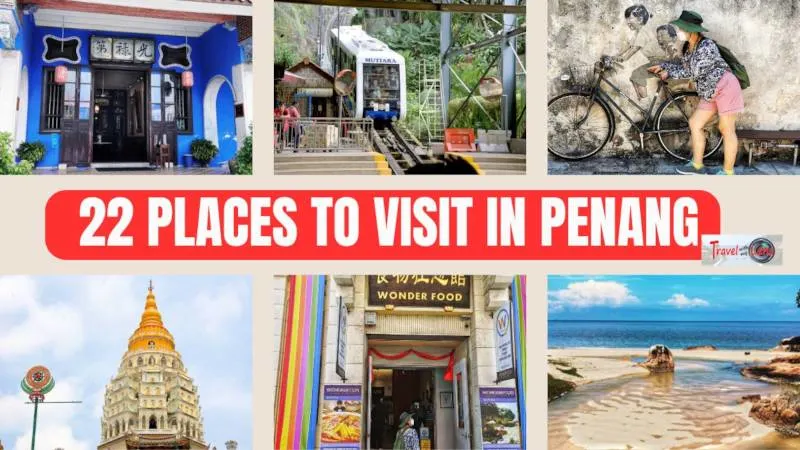
Please note that this list of best places to visit in Penang is in no particular order, but I might inadvertently place the ones I liked at the beginning. Everyone has individual preferences; some prefer nature, while others prefer culture. There are many to choose to visit at this UNESCO World Heritage Site. The decision is yours!
1. Kek Lok Si Temple

Kek Lok Si is an undeniable landmark of Penang that you must visit, no matter how busy you are. The temple's pagoda is an iconic building, as you may have seen on many postcards of Penang.
It is a huge Buddhist temple that you should allocate half a day to visit. There are a few unique attractions at this temple. The most notable one is, of course, the pagoda, which has eight levels. For a small fee, you can go up to the top level and enjoy an incredible panoramic view of Georgetown.

Another attraction is the huge Guan Yin statue. The bronze statue is a magnificent architecture, slightly over 30 meters tall. There is an inclined lift service to reach the Guan Yin statue, located at one of the highest points of the temple.
We have a separate complete article about Kek Lok Si where you can learn more about it.
2. Penang Hill (Bukit Bendera)

When visiting Penang, there are two must-see places: the Kek Lok Si Temple and Penang Hill. To fully explore Penang Hill, plan to spend at least half a day there. As it is the highest point on Penang Island at slightly over 800 meters, the hill offers a panoramic view of the entire island.
Most tourists use the funicular train, which has been operating since 1923, to reach the top. Alternatively, you can hike up, which takes a few hours.
Despite not being very high, Penang Hill has a unique vibe due to its colonial-era architecture, plus one of the oldest Hindu temples and a mosque on the hill. The area is pedestrian-friendly and free of cars.
The Habitat is a popular nature exploration center on Penang Hill. It has raised pathways and trails through dense forests, allowing visitors to observe various plant and animal species at their leisure. The Curtin Crest Treetop Walk is a must-try, offering a breathtaking view of the surrounding scenery from the highest point on Penang Island.

Another attraction is the Langur Way Canopy Walk, 40 meters above the ground and 115 meters long.
There are also eateries offering local food, including David Brown's restaurant, the highest garden restaurant in Penang.
Please read our full article about our recent trip to Penang Hill for more details.
3. Karpal Singh Drive

Karpal Singh Drive is located in Jelutong, Penang. The promenade is named after the late Karpal Singh, a prominent Malaysian politician. It spans approximately 800 meters and has a paved pedestrian walkway on one side and commercial shop lots on the other side of the road. You can enjoy a beautiful view of the Penang Bridge and harbor from here. It is a popular spot for a leisurely stroll in the evening and gatherings among the locals.
In the middle section of the walkway, there are modern art sculptures, including "Celebration of Our Blue Sky" and the "Rhythm of Light," created by the Japanese artist Hiltori Nakayama.
It is also a perfect place to find food, as there is a large food court called Fisherman Wharf at the end of Karpal Singh Drive.

Overall, I found that Karpal Singh Drive is currently better than Gurney Drive, as Gurney Drive's development has not yet been fully completed. The food court offers much better and superior quality than the Gurney Drive food court.
4. The Esplanade of Penang

The Penang Esplanade (Padang Kota Lama) is Penang's prominent seafront. Fort Cornwallis is also located there. In addition to the fort, several historical buildings are located there, including the City Hall, the cenotaph, and the clock tower.

There are a few places to visit in Penang, including Fort Cornwallis, the mural arts, the Food Museum, and clan jetties, all within walking distance from the Esplanade.
5. Fort Cornwallis

Fort Cornwallis is the largest standing fort in Malaysia. The fort was built in 1786 by Captain Francis Light, who first landed in Penang. It was initially constructed as a defense against pirates and potential invasions. Despite being built for the military, it served as the administration center rather than for defense.
The fort is approximately 10 feet tall and designed like a star. It has several architectural features inside, including cannons, a statue of Captain Francis Light, a Chapel, and a lighthouse.
6. Penang Mural Art

There are a few streets famous for mural art within walking distance from the Esplanade of Penang. One of the most well-known and widely spread on the Internet is the mural art of a bicycle.
However, I have seen several mural arts, including Concubine Lane in Ipoh. To be frank, this is common. What intrigued me in this area was not the murals but the traditional architecture, which was delightful and interesting to watch. Below are a few images I have taken within walking distance of the murals.


7. Chew Jetty

A few minutes' walk from the murals is the Chew Jetty. Chew Jetty is unique because traditional wooden houses are built on stilts above the water. Some Chinese families still live here, and several Chinese temples and a community hall are also located here.
If you walk to the end end of the jetty, you'll be treated to breathtaking vistas of the surrounding sea and Penang Bridge.

It has a fascinating history that dates back more than a hundred years. It started as a settlement for Chinese immigrants from the Chew clan who came to Penang looking for work in the early 20th century. Many of them began working as port laborers and coolies. Some later became self-employed as ferry operators, transporting people and goods between anchored ships and the harbor. They eventually brought their families from China and settled here, forming the Chew Jetty settlement.
8. Penang Wonderfood Museum

Wondfood Museum is worth a visit. I've visited many museums, but this one is truly unique.
The museum features photos and 3D structures showcasing different types of Malaysian food. It highlights the country's diverse cuisines, including Malay, Chinese, and Indian.

The museum displays street food scenes that perfectly capture the bustling atmosphere of downtown Georgetown. It also has larger-than-real food reproductions, making it a great place to take Instagram-worthy photos that could even go viral.
You can also find mockups of food stores where you can take pictures. Some food props are interactive, so you can pick them up for a photo.

Other places to visit in Penang include some religious sites. Penang's diverse historical background has made it very religious, which means you will find various mosques, temples, and churches. Below (No. 9-11) are a few notable ones we visited. 👇🏽👇🏽
9. Wat Chayamangkalaram (Reclining Buddha Temple)

There is a large courtyard with two giant dragons on the left and right, guiding you into the main entrance of the Temple Hall. Inside the hall, you'll see the statue of the reclining Buddha, which almost fills the entire space from left to right.

The temple was built in 1900 after Queen Victoria of the United Kingdom granted the land on May 30, 1845. The temple is renowned for its impressive gold-plated reclining Buddha, which is 32 meters long and is one of the longest reclining Buddha statues in the world. The hall also features various mythical elements and multiple smaller Buddha statues in different poses. The architecture reflects a blend of Chinese, Thai, and Burmese influences.

The temple is open daily from 6:00 AM to 5:30 PM, and admission is free. However, donations are encouraged to support and maintain the temple. Photography is allowed inside, but visitors must remove their shoes before entering the temple as a sign of respect.
10. St. George’s Anglican Church

St. George's Anglican Church is located in Georgetown and is one of the heritage buildings dating back to the 19th century. It is recognized as one of the oldest Anglican churches in Southeast Asia. The British East India Company established the church in the 1800s. Today, it still serves as an active place of worship.
11. Aceh Mosque

Aceh mosque, also known as Masjid Melayu Lebuh Acheh, is a historical 19th-century mosque and one of the oldest mosques in Penang, founded in 1808. Its Arab-style minarets and Acehnese roof set it apart, making it unique compared to the predominantly Indian Muslim-built mosques nearby.
12. Gurney Drive

Gurney Drive used to be my favorite place in Penang, but recent continuous redevelopment has made it less appealing.
The difference between the new and old Gurney Drive is quite extensive. First, they have added a large piece of reclaimed land, wich is now a recreation park. It also includes two promenades, the Upper and the Lower Promenade. The Lower Promenade is near the sea's edge, whereas the Upper Promenade is higher and closer to the main road.
At the end of the promenades is Gurney Bay, where anyone can still walk down to a small beach.
The promenades have a few cemented pathways now used as jogging and bicycle lanes. There are also a few family entertainment areas, including a circular red-colored long slide for kids and a roller skating area. It's now turned into a park for activities for the whole family.

However, the construction hasn't been completed and is only half done. If you walk towards the left, as if facing the sea, you will find that a lot of undeveloped land is barred from entry.
So we walked to the other end of Gurney Drive to the old hawker center to get some local food. Please refer to our article about food in Penang, which provides in-depth details of what to eat there.

We decided to take half a day to drive along the coastal road of Penang Island for a round-island trip. Penang is a small island, so driving nonstop only takes two hours. Below are the places (No. 13 to No. 19) not in Georgetown, which are along the round island trip. 👇🏽👇🏽
13. Penang Floating Mosque

The floating mosque of Penang is one of the most important mosques in Penang Island. It is located in Tanjung Bunga. It started as a small mosque dating back to the 1900s, but a new mosque was constructed in the early 2000s due to the growing Muslim population. This new mosque features a blend of Middle Eastern and local architectural styles, with prominent minarets as high as a seven-story building. It is built on stilts over the sea, giving the appearance of floating during high tide.
14. Penang National Park

I visited Penang National Park two years ago and had a fantastic experience I'd like to share. The park is a hidden gem in Penang, featuring beautiful beaches and moderately challenging jungle treks. The highlights of our hike were reaching Kerachut Beach, home to a turtle conservation center and a unique meromictic lake where seawater and freshwater meet.
During our trek, our guide pointed out interesting sights, such as the Pokok Rengas Ayam (Chicken Rengas Tree), a member of the mango family, and warned us about its poisonous sap.

We passed by Bukit Belah, where we saw the remains of a hill split in half by loggers using only a hoe. According to local tales, this feat was accomplished in 10 days with only seven people, which we found incredible.
Pantai Kerachut, or Turtle Beach, has no internet or phone signal. Our guide arranged for a boatman to wait at the beach, sparing us the long trek back through the jungle.
If you are a nature lover, Penang National Park is one of the places to visit in Penang. It's suitable for families and nature enthusiasts alike.
Watch our video shot at Penang National Park during our visit.
15. Batu Ferringhi Beach

After visiting the floating mosque at Tanjung Bungah, we drove past Batu Ferringhi Beach. There weren't many people during our visit, probably because it was around 3:00 pm and very sunny. This beach is popular among tourists and locals, and many hotels are there. If you come to Penang and stay at one of the beach resorts, you will love the beaches, especially during sunset.

16. Tropical Fruit Farm

The Tropical Fruit Farm is in Teluk Bahang, a popular agritourism destination. Established in 1993, it houses over 200 species of fruits worldwide. We stopped by to purchase fruit juice during our visit but did not take the guided tour. If you have the time, you can join a guided farm tour to see the fruit trees and sample different types of fruits.
17. Escape Theme Park

The Escape Theme Park is located in Teluk Bahang and offers a variety of thrilling activities designed for all ages.
We did not enter the park during this trip because we just wanted to drive around the island.
Based on our understanding, the key attractions at this place are the long tube water slide, which measures more than 1000 meters, and the long zip coaster, which is also more than 1000 meters long. If we have the opportunity, we will definitely consider returning.
18. Entopia (Penang Butterfly Farm)
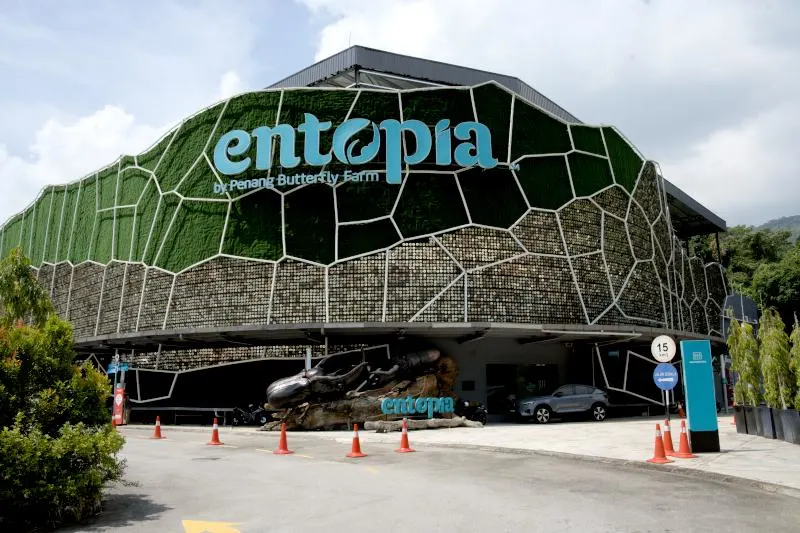
About 100 meters from the Escape Theme Park is the Penang Butterfly Farm, now known as Entopia. We have visited several butterfly parks and gardens in other places, so we decided to skip this one. If we come to Penang again and have time, we will visit this large butterfly farm much bigger than all the butterfly parks I have visited before.
19. Snake temple (福兴宫)
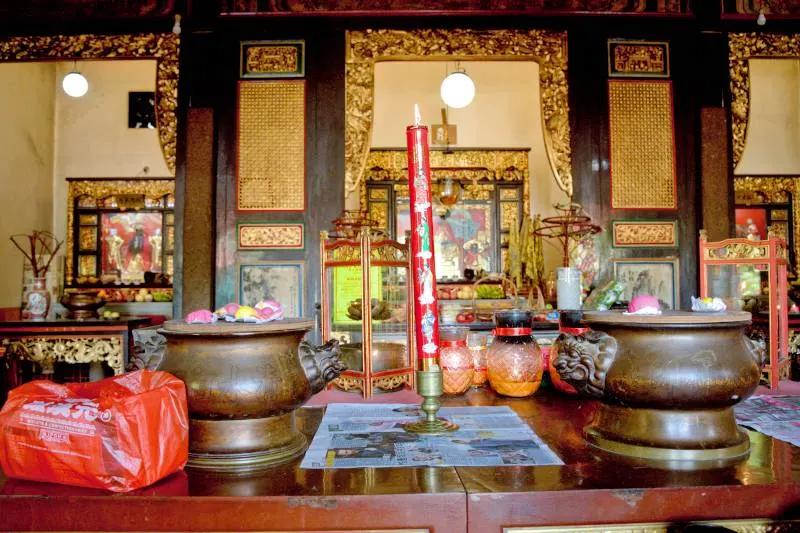
The last stop of our round island road trip was the snake temple in Bayan Lepas.
I visited this place 40 years ago and still vividly remember seeing snakes coiled around burning incense. However, I was slightly disappointed this time as I saw no snakes.
According to a signboard, many snakes are in the trees, and tourists are warned not to touch them. We tried hard to spot one, but we had no luck today.
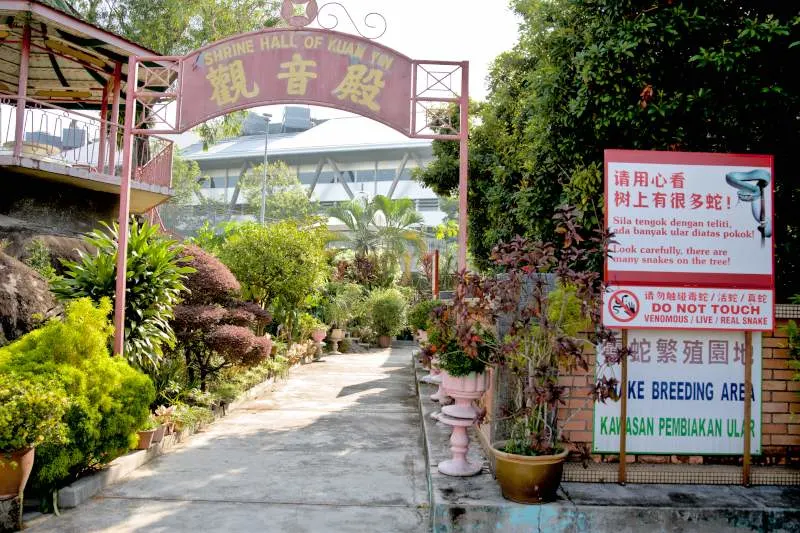
The temple is notable for housing pit vipers, which are believed to be the reincarnation disciples of Chor Soo Kong (清水祖师/祖師公), the main deity of the temple.
20. Cheong Fatt Tze Mansion (The Blue Mansion)
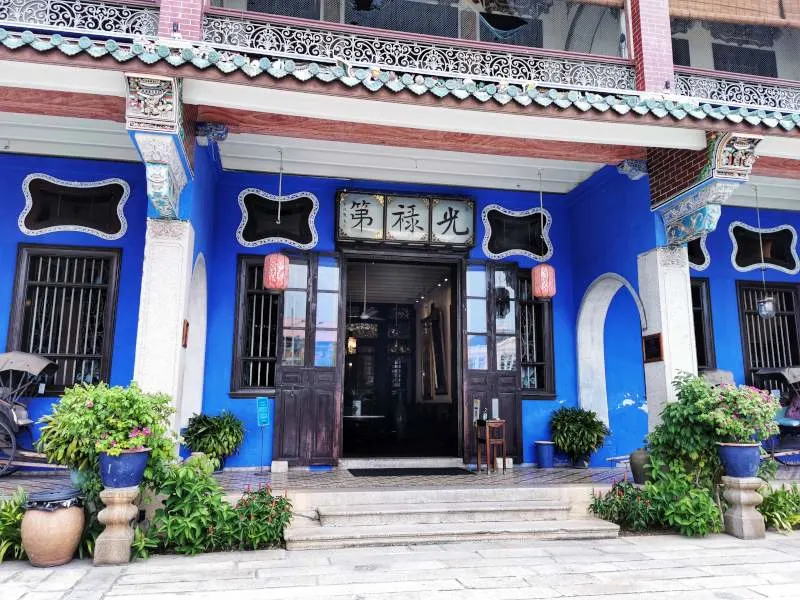
The Blue Mansion is a very old mansion located at the center of the town. It has been around for over 100 years and has now been converted from a tycoon's mansion to a high-class hotel. You can stay the night there, as we did, or choose to pay an entrance fee, which includes a guided tour.
The Blue Mansion began in the late 19th century when Cheong Fatt Tze wanted to build a house symbolizing grandeur and sophistication. Entering the mansion felt like stepping into a traditional old Chinese mansion.
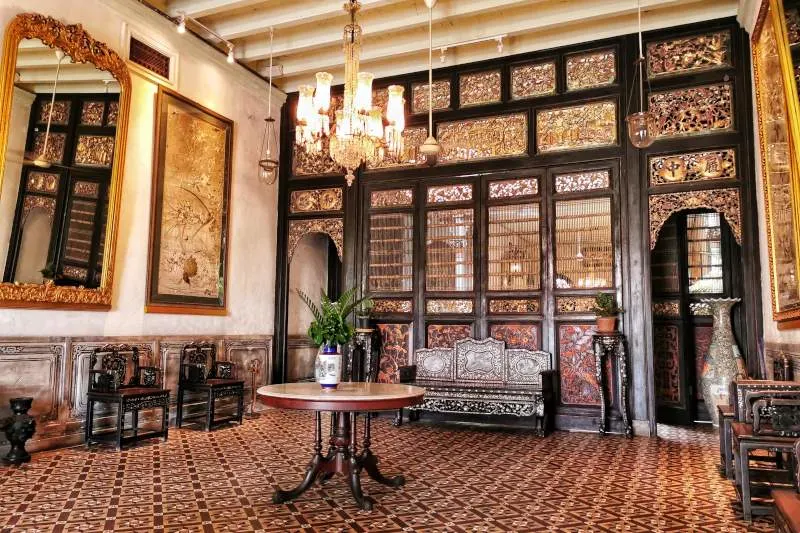
We walked past the main hall and then the courtyard, feeling as if we had been transported back to the early 19th century.
The main hall now serves as the check-in area for the boutique hotel, but in the past, it was the formal area of the house, likely male-dominated.
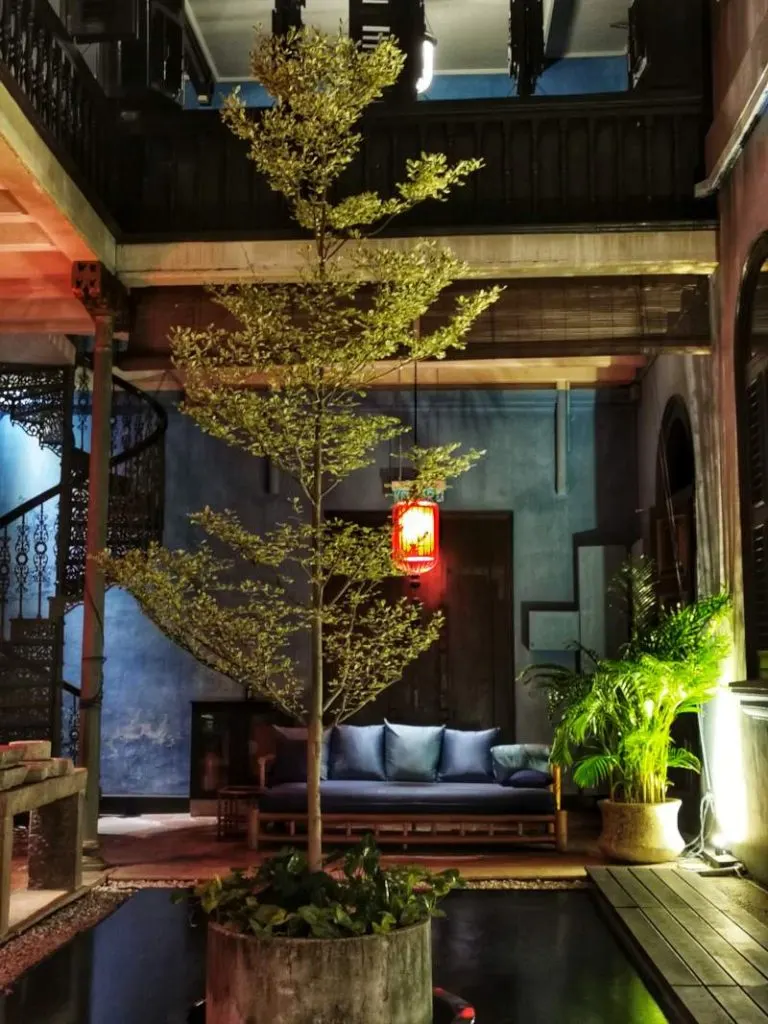
The courtyard is adorned with cast iron columns imported from Scotland.
Moving to the upstairs hall, we learned about the mansion's historical figure, Cheong Fatt Tze, known as the "Rockefeller of the East." He was a successful Chinese migrant who became one of the region's wealthiest and most politically connected men.
Looking into the left and right wings of the mansion, we observed the remaining four courtyards - two on each side - each with its unique color scheme. The original cast iron spiral staircase led up to the first floor.
There is a museum showcasing photos from when the mansion was the gathering place for the society's elite.

You can stay overnight here, as it is now converted into a hotel. However, if you choose to visit the mansion, it is still worth it, but you must pay a fee to join a guided tour, which takes about one hour.
I would rank Blue Mansion as one of Penang's best places. Please read our blog post about the complete tour of the Blue Mansion here.
21. Botanical Garden
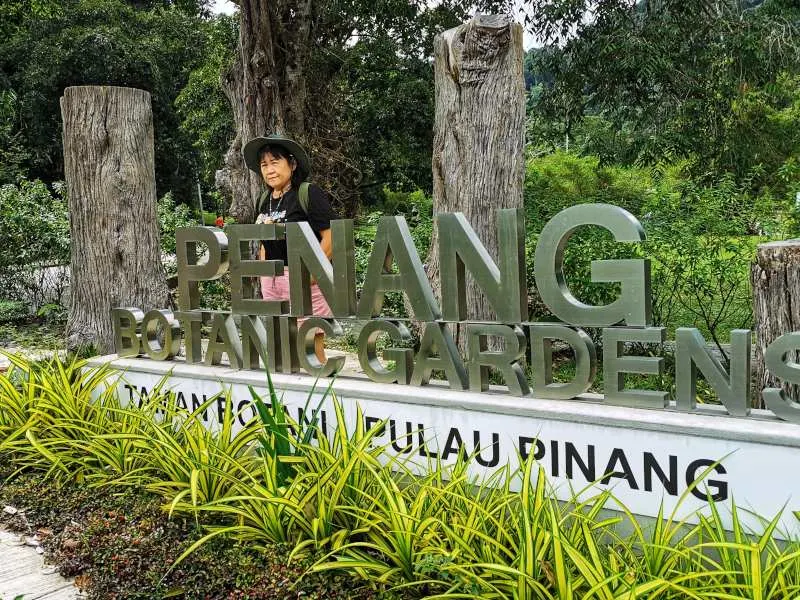
Due to time constraints, I couldn't explore the entire garden, but I did enjoy the peaceful environment and lush greenery. The garden has well-defined walkways, making navigating easy without the fear of getting lost. You can walk, jog, or hike along these paths, and it typically takes 40 to 60 minutes to complete a full circuit with continued walking. The garden covers approximately 30 hectares and has various unique plant collections.
While I'm not particularly interested in trees, the variety of trees in the garden is clearly labeled. One thing that stood out to me was the captivating appearance of the cannonball tree.
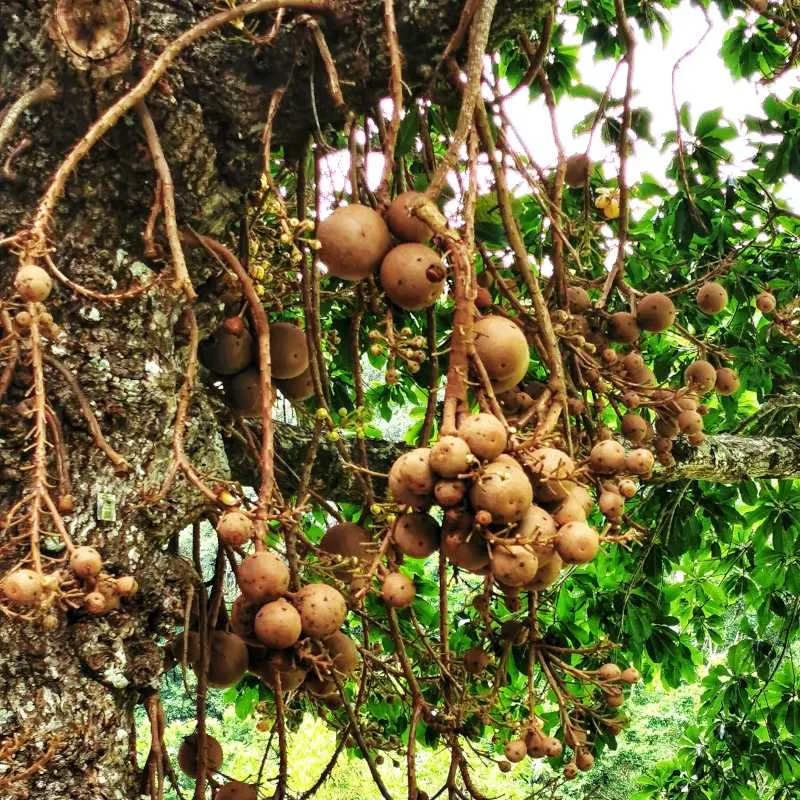
The garden is a great place to unwind, especially early morning or evening. However, please be cautious due to the presence of monkeys in the area. It's best not to provoke them or offer them any food.
22. Penang Street Food
Lastly, you should definitely try the food here, as it is world famous. You cannot just go to one destination; you have to visit many places to try different kinds of food. I highly recommend checking out our articles specifically on Penang food.

The above is the complete list of things and places we visited during our trip to Penang. Have you been to any of these places? Which ones are you planning to visit on your next trip? Let me know in the comments below.
Watch our video version of this article, 22 Best Places to Visit in Penang on our YouTube:
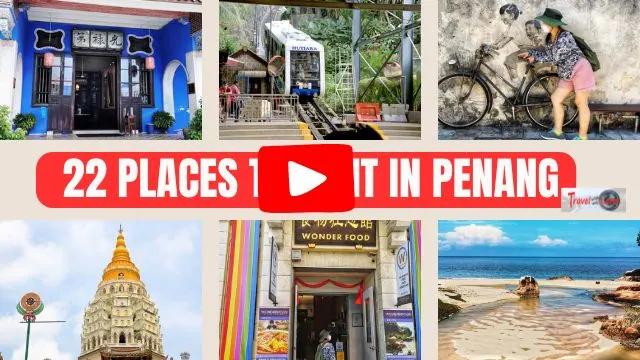
I am a local Malaysian, and it only takes me two and a half hours to drive from Kuala Lumpur. I will update this article to provide you with the latest information whenever I revisit Penang.
